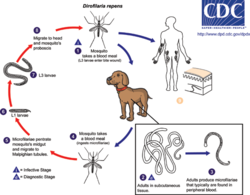Dirofilariasis
Dirofilariasis is a disease caused by Dirofilaria repens or Dirofilaria immitis. They are thin white worms and belong to the filaria. They commonly attack beasts, mainly canine and feline. Man is a random host, in man the larva does not mature. The source of the infection is a mosquito (vector).
Dirophilariasis is one of the so-called emerging infectious diseases. It is an infectious disease that is observed worldwide and is often known to be closely linked to human travel, animal movements and global climate change, especially global warming. [1]
Life cycle[edit | edit source]
The larvae develop in mosquitoes for 15-18 days. As soon as a mosquito bites a human, the larvae enter the skin and into the blood. The larvae in humans do not mature in the adult, but nest in some organ, where they form nodules. They most often affect the subcutaneous tissue, lungs, heart or eyes. They can also become trapped in lymph nodes and in the abdomen.
Clinical signs[edit | edit source]
Dirofilaria repens[edit | edit source]
- In the Czech Republic it is more common than Dirofilaria immitis (in the Czech Republic only 5 cases, but it is still expanding and is approaching the Czech Republic from the classic places of occurrence).
- The most common cause of symptomatic heartworm disease. [1]
- When infected, a person forms nodules in the skin, in the orbit area, in the vitreous, conjunctiva and eyelid.
Dirofilaria immitis[edit | edit source]
- Czech hairy dogs.
- It is often called a 'heartworm' because it is very fond of settling in the heart and causing cardiopulmonary damage (in the dog).
- However, it most often causes asymptomatic infections in humans and dogs. [1]
- In humans, the larva is most often caught in the subcutaneous tissue, eye or lungs, where it forms nodules.
![]() Heartworm infections can elicit a strong immune response and this may be related to some other symptoms located outside the affected area. [1]
Heartworm infections can elicit a strong immune response and this may be related to some other symptoms located outside the affected area. [1]
Diagnostics[edit | edit source]
- Microscopic examination collected tissues (biopsy, excision).
- Detection of specific antibodies (serum, vitreous) or DNA parasite.
Therapy[edit | edit source]
- Anthelmintics (ivermectin, diethylcarbamazine), which damage worm muscle. [1]
- Surgical removal of the worm.
Prevention[edit | edit source]
Cases of heartworm disease are likely to increase due to the spread of the parasite itself and the ever-increasing travel of people with pets (dogs and cats). Travelers should also protect themselves from mosquitoes in non-malarial areas. [1]
Links[edit | edit source]
[edit | edit source]
Reference[edit | edit source]
DITRICH, O. Case of heartworm disease imported from Greece (Brief introduction to heartworm disease in humans and case report) . Paper presented at the Travel Medicine Conference: parasites becoming more and more topical. Prague. April 7, 2009. Also available from < http://www.parazitologie.cz/akce/doc/sbornik/sbornik.pdf >.
Used literature[edit | edit source]
CHANOVÁ, Marta. Diseases caused by nematodes III (Filaria) [lecture on the subject Parasitology, General Medicine, 1st Medical Faculty, Charles University]. Prague. 11/23/2015
- CHANOVÁ, Marta. Diseases caused by nematodes III (Filaria) [lecture for subject Parasitology, specialization General medicine, 1. LF Charles University]. Prague. 23/11/2015.


